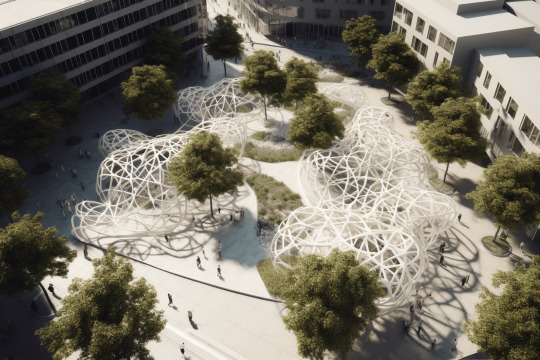#agent-basedmodels
Explore tagged Tumblr posts
Text
Algorithms for Eco-Friendly Urban and Architectural Planning

As the world faces an increasing number of environmental challenges, architects and urban planners are searching for innovative solutions to create sustainable, eco-friendly spaces. One promising avenue is to harness the power of generative art algorithms based on natural patterns and processes. By mimicking the intricate designs found in nature, these algorithms offer a new approach to environmentally responsible urban and architectural design.
Generative Art Algorithms: Nature's Blueprint
Generative art algorithms are mathematical and computational processes that simulate the organic growth and development of natural forms. These algorithms often employ fractals, cellular automata, agent-based models, and artificial life systems to create complex, evolving patterns that mirror the beauty and efficiency of nature. - Fractals: Fractals are self-similar patterns that repeat at different scales. They are prevalent in natural phenomena such as tree branching, snowflakes, and coastlines. Fractal algorithms can help architects create space-efficient, structurally sound designs that minimize waste and material usage. - Cellular Automata: Cellular automata are discrete models that simulate the behavior of complex systems through a grid of cells. Each cell follows a simple set of rules, which results in large-scale patterns and structures. This can help urban planners design adaptable, resilient cities capable of responding to environmental changes. - Agent-Based Models: Agent-based models use individual agents, each with their own set of rules, to simulate the interactions and collective behavior of a system. These models can be applied to urban planning to optimize transportation systems, pedestrian movement, and resource distribution. - Artificial Life Systems: Artificial life systems mimic biological processes, such as growth and reproduction, to create evolving forms. These algorithms can help architects design buildings that adapt to their environments and respond to changing conditions.
Generative Art Algorithms in Urban and Architectural Planning
By employing generative art algorithms, architects and urban planners can create spaces that are not only aesthetically pleasing but also environmentally friendly. Some key applications include: - Sustainable Resource Management: Generative algorithms can optimize the use of natural resources such as sunlight, wind, and water, reducing a building's energy consumption and environmental footprint. - Green Infrastructure: These algorithms can inform the design of green roofs, walls, and other living architecture elements, which not only enhance aesthetics but also improve air quality, reduce urban heat island effect, and support local biodiversity. - Adaptive Urban Design: Cities can be designed to respond dynamically to environmental changes, promoting resilience and sustainability. Generative algorithms can help planners create adaptive transportation systems, decentralized energy grids, and efficient resource distribution networks. - Material Efficiency: Generative art algorithms can help minimize material usage and waste during construction by optimizing structural designs and promoting the use of local, sustainable materials. - Biophilic Design: By incorporating nature-inspired patterns, generative art algorithms can create spaces that promote human well-being and productivity, while fostering a stronger connection between people and the natural world.
Conclusion
The convergence of generative art algorithms and eco-friendly urban and architectural planning has the potential to reshape the way we design and inhabit our cities. By embracing nature's wisdom and creativity, we can create spaces that are not only aesthetically pleasing but also sustainable, resilient, and harmonious with the environment. As our understanding of these algorithms continues to grow, we can expect to see even more innovative applications that will help us build a greener, more sustainable future. Read the full article
#agent-basedmodels#architecturaldesign#artificiallifesystems#biophilicdesign#cellularautomata#eco-friendly#fractals#generativeartalgorithms#greeninfrastructure#urbanplanning
9 notes
·
View notes